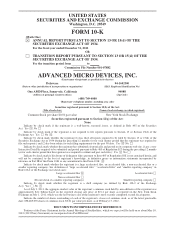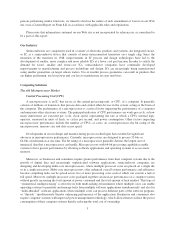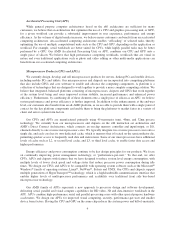AMD 2011 Annual Report Download - page 12
Download and view the complete annual report
Please find page 12 of the 2011 AMD annual report below. You can navigate through the pages in the report by either clicking on the pages listed below, or by using the keyword search tool below to find specific information within the annual report.Desktop. Our APUs for desktop PC platforms consist primarily of the AMD A Series “Llano” APU and
the E-Series “Zacate” APU. The desktop A-Series APU was designed for mainstream desktop platforms and
comes in quad-, triple- and dual-core versions. We designed the desktop E-Series APUs for all-in-ones, or
desktop computers that combine the APU or CPU with the monitor, and small form factor desktop PCs. Our
CPUs for desktop PC platforms consist of the following: AMD FX processors based on the “Bulldozer” x86
multi-core architecture, which are available with eight-, six- and quad- core versions, AMD Phenom II
processors, which are available with six-, quad-, triple- and dual- core technology, AMD Athlon II processors,
which are available in quad-, triple- and dual- core versions, and AMD Sempron processors. We designed the
AMD FX processors for multitasking, high resolution gaming, and HD media processing.
Embedded Processor Products
Our embedded products address customer needs in PC-adjacent markets. Typically, our embedded products
are used in applications that require high to moderate levels of performance where key features include low cost,
mobility, low power and small form factor. High performance graphics are increasingly important in many
embedded systems. Customers of our embedded products include vendors in industrial controls, digital signage,
point of sale/self-service kiosks, medical imaging, set-top box and casino gaming machines as well as enterprise
class telecommunications, networking, security, storage systems and thin-clients, or computers that serve as an
access device on a network.
The embedded market has moved from developing proprietary, custom designs to leveraging the industry-
standard x86 instruction set architecture as a way to reduce costs and speed time to market. Customer
requirements for these systems include: very low power for small enclosures and 24x7 operation, support for
Linux, Windows and other operating systems, and high-performance for increasingly sophisticated applications.
Other requirements include advanced specifications for industrial temperatures, shock and vibration, and
reliability.
Our embedded platforms include options from the AMD Opteron, AMD Athlon, AMD Turion, and AMD
Sempron processor families; the AMD Embedded G-Series, which is the embedded version of our APUs; the
AMD Radeon™ graphics processor family; and numerous AMD chipsets. These products are part of the AMD
Longevity Program, which provides for an availability period of up to five years in some cases in order to
support lengthy development and qualification cycles and long-term life of the system in the market.
In May 2011, we announced two additional AMD Embedded G-Series APUs. These low-power processors
are designed for compact, fanless embedded systems like digital signage, kiosks, and mobile industrial devices.
Also in May 2011, we introduced the AMD Radeon E6760 embedded discrete graphics processor, which offers
embedded system designers the combination of OpenCL™, and AMD Eyefinity-enhanced support. OpenCL, or
Open Computing Language, is the programming standard for general-purpose computations on systems that use
more than one kind of processor, such as an APU. AMD Eyefinity is a technology that allows a game to be
played across multiple screens in a panoramic view with minimal distortion by allowing up to six monitors to be
connected to one graphics processor.
Chipset Market and Products
Chipsets send data between the microprocessor and input, display and storage devices, such as the keyboard,
mouse, monitor, hard drive and CD or DVD drive. Chipsets perform essential logic functions, such as balancing
the performance of the system and removing bottlenecks. Chipsets also extend the graphics, audio, video and
other capabilities of computer systems. All desktop and mobile PCs as well as servers incorporate a chipset. In
many PCs, the chipset is integrated with additional functions such as a GPU. An integrated chipset solution is
commonly known as an integrated graphics processor, or IGP, chipset. Chipsets that do not integrate a graphics
core are connected to what is known as a discrete GPU. IGP chipsets offer a lower cost solution and in some
circumstances can offer reduced power consumption or smaller system form factors. A majority of PCs make use
6
























